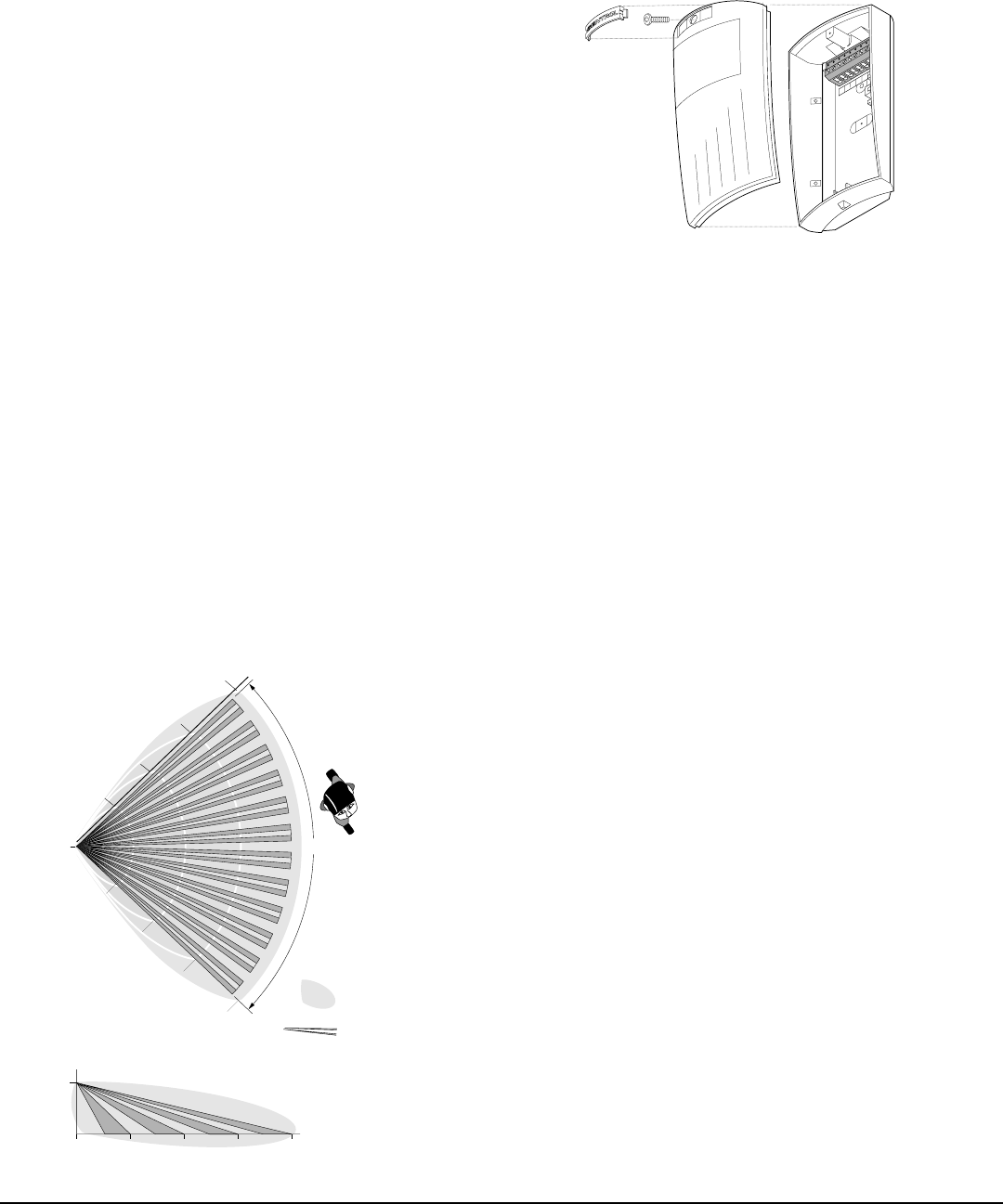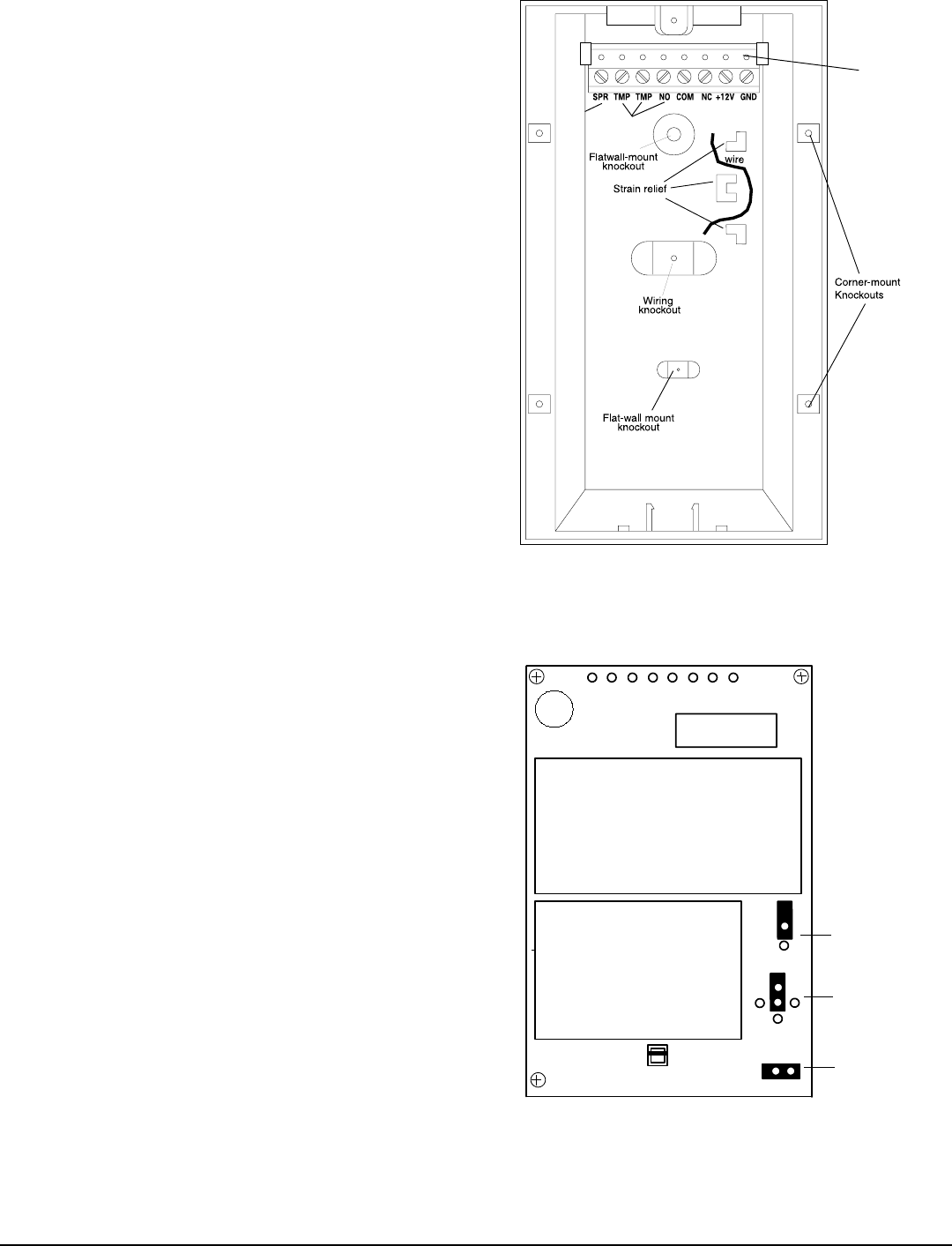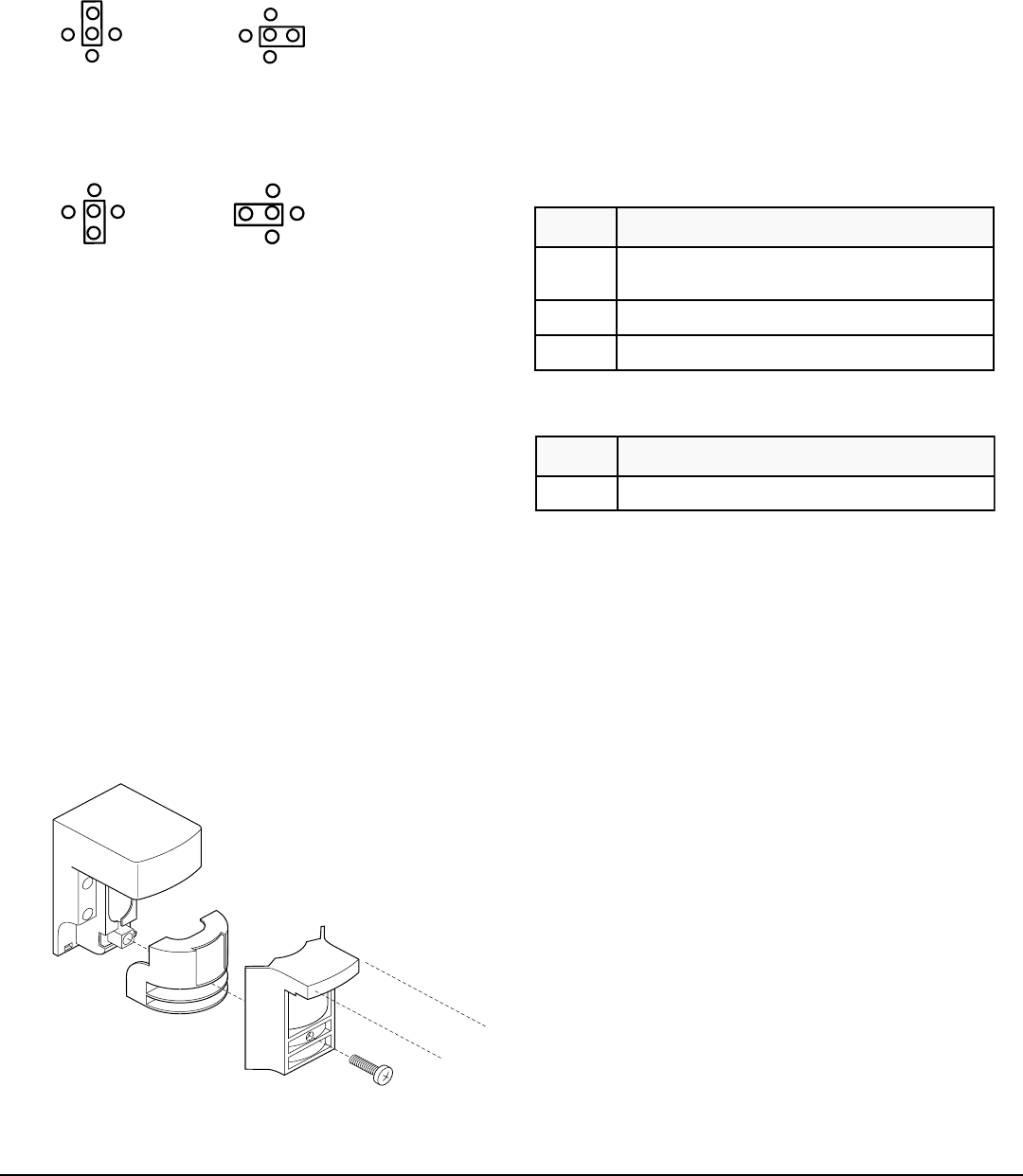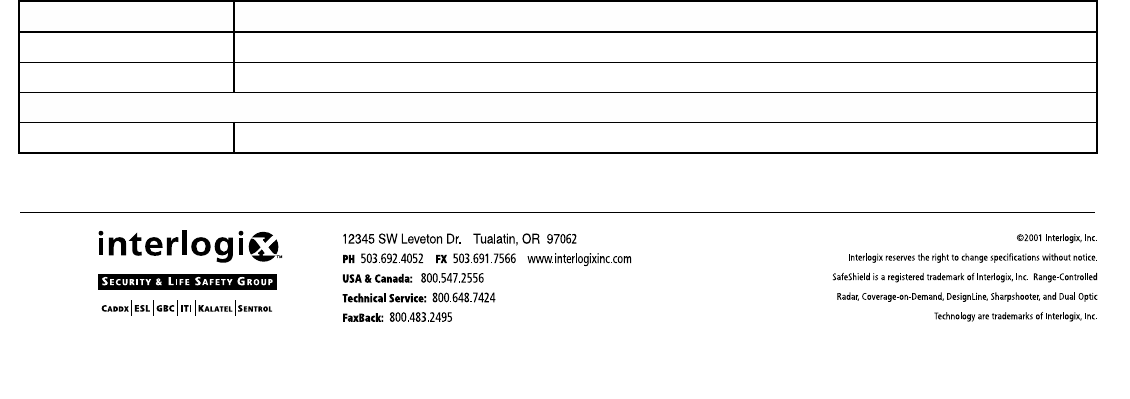UTC Fire and Security AA2 Field Disturbance Sensor for Security Systems User Manual
UTC Fire & Security B.V. Field Disturbance Sensor for Security Systems
Contents
- 1. 8
- 2. User Manual
- 3. Users Manual
User Manual
EXHIBIT B – User Manual
FCC ID# CGGAA2

1
Sentrol RCR
Sentrol RCR
Range-Controlled Radar Detector
Models: RCR-A (Form A)
RCR-C (Form C)
Installation Instructions
Description
The RCR detector combines range-controlled radar (RCR)
technology with a passive infrared (PIR) system to increase
false alarm immunity by allowing it to sense human-sized
objects within a specified range. Both the RCR and PIR systems
must be triggered to set off an alarm, unless in Microwave
only mode.
The detector is designed to use a 12VDC power supply pro-
vided by a UL Listed alarm control panel.
Features
The detector provides the following features:
·High-security mode - Internal jumper allows you to disable
the PIR, and use the RCR system only to detect intruders
faster. This mode can be used for covert installations
(mounted behind ceiling panels or walls).
·Selectable range up to 35 feet - Internal jumper allows
radar range selection to optimize coverage.
·LED indicator - A multi-color LED provides detector status.
·Tamper switch (RCR-C only) - Activated when the pins on
the circuit board are removed from the terminal sockets on
the base.
Parts
The following parts are included with the detector:
·RCR detector
·1 screw to join the case halves
·3 factory-installed jumpers
Selecting a Location for the Detector
The detector can be mounted in a corner or on a flat wall. Use
the following guidelines to determine the best location to install
the detector:
·Mount the detector so the expected movement of an intruder
is across the detection pattern. See Figure 2.
·Mount the detector on a stable surface 7 to 9 feet high.
·DO NOT mount the detector within 2 feet of any metallic
objects.
·DO NOT place any objects in front of the detector that may
prevent a clear line of sight. (Not applicable in RCR only
mode.)
·Avoid locations that expose the detector to possible false
alarm sources such as:
Moving or vibrating objects (fans, pulleys, conveyor belts)
Electronic fields (electric motors, high voltage equipment)
Water spray or corrosive environments
Heat sources in the field of view (heaters, radiators)
Windows in the field of view
Strong air drafts on the detector (fans, air conditioners)
·When installing multiple detectors:
DO NOT mount detectors facing each other
Use the 9-foot range when mounting detectors back to back
Mount them at least 20 feet apart
Use shorter range settings to avoid overlapping radar
coverage
Figure 2 - RCR and PIR Coverage Patterns
SPRTMPRTMPRNO COM
Figure 1 - Detector (exploded)
0'
6.9'
9' 18' 27' 35'
Side View
90
0'
9'
18'
27'
35'
35'
27'
18'
9'
Top View
RCR Viewing Area
PIR Viewing Area
°

2Sentrol RCR
Figure 3 - Detector Base
Installing the Detector
All wiring must conform to National Electric Code (NEC) and/or
local codes having jurisdiction.
Important: DO NOT use this device for safety
interlock applications.
Use the following steps to install the detector:
1. Run the security system wiring to the detector location.
2. To remove the front cover/electronic module, press down on
the lever at the bottom of the unit and pull the cover off.
Remove the nameplate and loosen the screw if necessary. To
remove the nameplate, insert a small screwdriver into one of
the nameplate side slots and gently push in on the nameplate.
See Figure 1.
CAUTION! Use anti-static precautions when handling
the circuit board.
3. If necessary, set the jumpers on the circuit board. See Setting
the Jumpers.
4. Remove the appropriate wiring and mounting knockout holes
from the back cover. The detector can be mounted on a flat
wall or in a corner. See Figure 3.
5. Pull the wires through the knockout holes and use the two
screws provided to attach the base to the wall. Use screw
anchors if necessary.
6. Strip 1/4 inch of insulation from each wire.
7. Run each wire through the strain relief and under the appro-
priate screw terminals on the base and tighten the screws.
See Figure 3.
8. Line up the tabs on the bottom of the cover/electronic module
with the corresponding tabs on bottom of the base and snap
the cover/electronic module firmly down onto the base.
9. Tighten the screw and replace the nameplate. See Figure 1.
10. Apply power. The green LED should light for approximately
25 seconds and then go out.
11. Walk test the coverage pattern as follows:
Walk throughout the intended coverage area.
Verify the detector alarms. See Understanding the LED.
Note: Most units walk test more accurately if the person
testing waits 10 seconds between tripping the unit and
walking again. This allows the detector to stabilize between
trips.
Terminal
sockets
Figure 4 - Main Circuit Board
J4
J3
J2
Microwave
only
Range
LED Disable
Spare RCR-C only

3
Sentrol RCR
Important: You need to set J2 as close to the intended
coverage range as possible. Overshooting the coverage
area may cause false alarms.
J3 LED - ON = LED enabled (factory default)
OFF = LED disabled
J4 PIR - ON = RCR Microwave only
OFF = PIR enabled (factory default)
Understanding the LED
The multi-color LED located on the bottom of the detector
indicates the status of the unit as described in the following
table.
Maintaining the Detector
When installed and used properly, the detector provides years of
service with minimal maintenance. You should walk test the
detector annually to ensure proper operation.
When the cover is removed, power is interrupted to the sensor.
Once the cover has been replaced, the green LED will illuminate
for 15 seconds while the sensor warms up. After the green LED
goes off, wait one minute and walk test the sensor.
SB01 Swivel Mount Bracket
For ceiling-mount applications that require 90 degree coverage,
an optional ceiling-mount swivel bracket (SB01) is available
from Interlogix. See Figure 5.
Figure 5 - SBO1 Swivel-Mount Bracket
DEL sutatS
deRdnamralanisirotcetedehT.noitcetedRCRdnaRIP .dehctiwssahyalereht
neerG.)mralaon(ylnonoitcetedRIP
wolleY.)mralaon(ylnonoitcetedRCR
Setting the Jumpers
The detector provides jumpers to select the detection range and
PIR and LED operation. See Figure 4.
J2 Range - Use the jumper to cover the center pin and the pin
indicating the desired range. No jumper = 27 feet and under.
9 feet and under 18 feet and under
27 feet and under 35 feet and under (factory default)
9'
18'35'
27'
9'
18'35'
27'
9'
18'
35'
27'
9'
18'
35'
27'
In RCR microwave only mode:
DEL sutatS
deR.noitcetedevaworcimRCR

4Sentrol RCR
Product Ordering
Specifications
Input voltage.......................8.5 to 18 VDC (UL: 10 to 16VDC)
Typical current..................................................................20mA
Maximum current..............................................................27mA
Electrical configuration.....................................RCR-A: Form A
RCR-C: Form C
Relay rating..............................RCR-A: 200VDC, 500mA max.
RCR-C: 200VDC, 250mA max.
Tamper (RCR-C only)........................................100ma, 50VDC
Detection range..............................................35' (10.7 m) x 90°
Target velocity..............................................0.5 ft/sec to 5 ft/sec
Alarm duration....................................................................5 sec
Mounting height.......................................7' to 9' (2.1 to 2.75 m)
Operating temperature........................32° to 122°F (0° to 50°C)
Relative humidity...............................5 to 95% non-condensing
Dimensions:
Width..................................................................2.8" (7.1 cm)
Depth..................................................................2.3" (5.7 cm)
Height..................................................................5.1" (13 cm)
Weight......................................................................6 oz (170 g)
Color......................................................................................white
Field wiring size.......................................................16-24 AWG
FCC Compliance
This device complies with Part 15 of the FCC rules. Opera-
tion is subject to the following two conditions:
(1) this device may not cause harmful interference
(2) this device must accept any interference received,
including interference that may cause undesired operation.
FCC ID:
rebmuNledoM noitpircseD
A-RCRyalerAmrofhtiwrotcetedradardellortnoc-egnaR
C-RCR stcatnocrepmatdnayalerCmrofhtiwrotcetedradardellortnoc-egnaR
seirosseccA
10BStekcarbtnuom-leviwS
1035261 Rev A 04/01